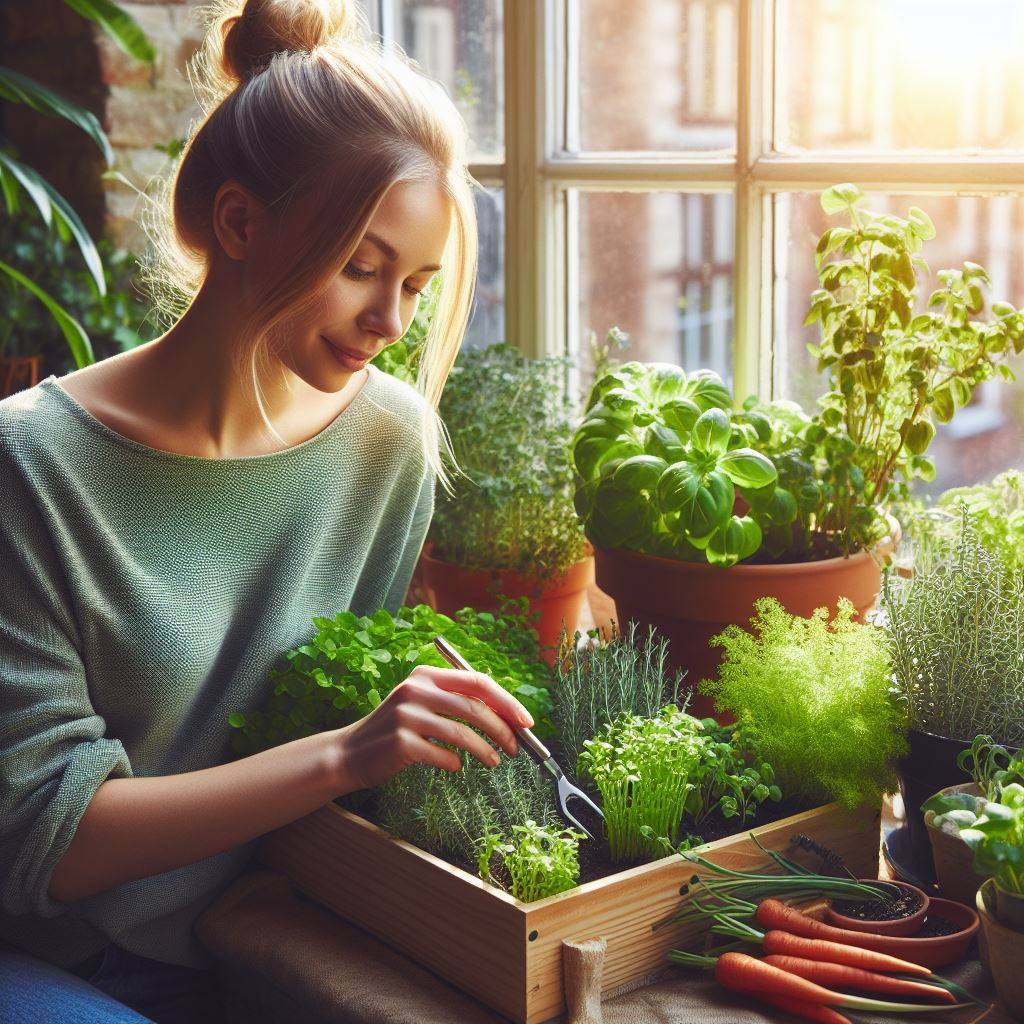Introduction
Exploring Portable Plots Mobile Garden Strategies: Longing for fresh veggies but constrained by space?
Say hello to portable plots! Ditch the traditional, static garden and unlock a world of flexible, mobile growing.
Imagine lush herbs thriving on your sunny balcony, vibrant tomatoes basking on your rooftop, or leafy greens flourishing by your doorstep.
Portable plots make it possible, offering a revolutionary approach to gardening that fits your life, not the other way around.
Forget cramped corners and fixed layouts.
Mobile gardens empower you to chase the sun, maximize microclimates, and adjust to your ever-changing needs.
Whether you’re a seasoned green thumb or a curious newbie, portable plots offer a gateway to delicious homegrown produce, no matter your space constraints.
Intrigued? Buckle up! This guide dives deep into the exciting world of mobile gardens.
We’ll explore innovative container options, unlock the secrets of soil and irrigation, and empower you to cultivate a thriving, portable haven for your favorite edibles.
So, grab your gardening gloves and prepare to be amazed!
Let’s embark on a journey where flexibility meets flavor, and where fresh, homegrown bounty is just a step (or wheelbarrow) away.
What are Portable Plots?
Define portable plots and explain their basic characteristics
Portable plots, also known as mobile gardens, are innovative gardening strategies that enable individuals to grow plants in restricted and temporary spaces.
These plots are designed to be movable, allowing gardeners to easily relocate them whenever necessary.
One basic characteristic of portable plots is their compact size, making them suitable for balcony gardens, patios, or even indoor spaces.
They are designed to maximize the use of limited space by using vertical gardening techniques, such as trellises or hanging baskets, to grow plants upwards instead of outwards.
Transform Your Agribusiness
Unlock your farm's potential with expert advice tailored to your needs. Get actionable steps that drive real results.
Get StartedAnother important characteristic is their lightweight and easily transportable nature.
Portable plots often utilize materials like lightweight containers, fabric planters, or portable raised beds, allowing gardeners to easily move the entire garden to different locations.
This flexibility is especially beneficial for renters or individuals who frequently relocate.
Various types and designs of portable plots available
- Container Gardens: Container gardens are one of the most common types of portable plots. These gardens are created using pots, buckets, or other containers filled with soil. They are easily portable, as gardeners can simply move the containers to different areas based on sunlight exposure or aesthetic preferences.
- Vertical Gardens: Vertical gardens are an excellent choice for limited spaces. They utilize vertical surfaces like walls or trellises to grow plants upwards, maximizing the use of vertical space. Options for vertical gardens include pocket planters, modular systems, or even repurposed materials like shoe organizers or pallets.
- Hanging Gardens: Hanging gardens are perfect for small balconies or indoor spaces. These plots involve suspending plants from overhead structures using hanging baskets or planters. The plants can be a variety of herbs, flowers, or even small fruiting plants.
- Raised Beds: Portable raised beds are ideal for individuals who prefer gardening at ground level but still require mobility. These beds are constructed using lightweight materials like fabric or wood, allowing gardeners to easily disassemble and relocate them as needed.
- Window Boxes: For individuals living in apartments or homes without outdoor spaces, window boxes offer a portable gardening solution. These boxes are installed on windowsills and filled with soil to grow small plants or herbs. They enhance the aesthetic appeal and provide a green touch to urban environments.
- Hydroponic Systems: Hydroponic systems are innovative portable plots that do not require soil. Instead, plants are grown in water containing essential nutrients. These systems are compact and suitable for indoor use, perfect for growing herbs or small vegetables without traditional soil gardening.
In short, portable plots are versatile and adaptable gardening strategies that allow individuals to overcome limited space challenges.
With their compact size and easily transportable nature, they enable gardening enthusiasts to grow their plants anywhere, be it on balconies, patios, indoors, or even in urban environments.
The various types and designs of portable plots offer a wide range of options to create beautiful and fruitful gardens in restricted areas.
Read: Eco-Urban Farming: Sustainable Water Practices
Advantages of Mobile Garden Strategies
Highlight the flexibility and convenience of portable plots
- Portable plots provide a flexible gardening solution.
- Gardeners can easily move their plots to different locations, accommodating changing needs.
- This flexibility allows gardeners to optimize their garden’s growth by adjusting for sunlight and soil conditions.
The ability to adapt to changing sunlight, weather conditions, and space limitations
- With portable plots, gardeners can easily adjust the position of their plants to maximize sunlight exposure.
- This adaptability is crucial when dealing with changing weather conditions like heavy rain or extreme heat.
- The ability to move the garden also enables gardeners with limited space to utilize small areas efficiently.
Ease of relocation, allowing gardeners to optimize sunlight exposure and temperature control
- Mobile garden strategies offer gardeners the opportunity to relocate their plots if needed.
- By moving the garden, gardeners can ensure consistent sunlight exposure throughout the growing season.
- Additionally, they can adjust the garden’s location to maximize temperature control, depending on the plants’ needs.
In fact, mobile garden strategies offer several advantages to gardeners.
The flexibility and convenience of portable plots allow for easy adaptation to changing needs and circumstances.
By adjusting the position of plants, gardeners can optimize sunlight exposure and effectively manage changing weather conditions.
Moreover, the ease of relocation enables gardeners to optimize sunlight exposure and temperature control throughout the growing season.
Overall, mobile garden strategies provide a practical solution for gardeners seeking flexibility, convenience, and the ability to adapt to various gardening challenges.
Read: Garden Mulching: Reduce Water Use Effectively
Types of Portable Plots
Container Gardening
- Containers such as pots, barrels, and other containers are used for planting.
- There are different materials and sizes available for container gardening.
- Tips for selecting the right containers and soil for specific plants should be provided.
Vertical Gardening
- Growing plants vertically using walls or trellises is an interesting concept.
- Vertical gardening has advantages, especially in small spaces.
- Examples of suitable plants for vertical gardening should be provided.
Raised Bed Gardening
- Raised beds offer benefits, such as improved drainage and soil quality.
- Different materials can be used for constructing raised beds.
- Tips for building and maintaining raised beds should be provided.
Explore Further: Soil Aeration Techniques for Healthier Roots
Tips for Managing Portable Plots
Proper watering and drainage are essential for the health of plants in portable plots
- Water regularly, but avoid overwatering as it can lead to root rot.
- Ensure that the pots or containers have proper drainage holes to prevent waterlogging.
- Use a well-draining potting mix that allows excess water to flow out easily.
Choosing the right plants for portable plots is crucial for their successful growth
- Select plants that are suitable for container gardening and have compact root systems.
- Consider the available space, light conditions, and climate before choosing plants.
- Herbs, salad greens, small vegetables, and dwarf varieties of flowers are ideal for portable plots.
Protecting portable plots from pests and harsh weather conditions is essential for their survival
- Install physical barriers, such as netting or fences, to keep away pests like rabbits or birds.
- Use organic pest control methods like companion planting, neem oil, or insecticidal soap.
- Move portable pots to a sheltered area or provide temporary covers during extreme weather events.
Regular maintenance and soil replenishment are necessary to ensure the long-term health of portable plots
- Monitor the plants for signs of pests, diseases, or nutrient deficiencies.
- Trim and prune plants as needed to maintain their shape and encourage healthy growth.
- Replace old and depleted potting soil with fresh soil every year or as necessary.
- Add organic fertilizers or compost to the soil periodically to replenish nutrients.
In essence, managing portable plots requires proper watering and drainage, careful plant selection, protection from pests and weather, as well as regular maintenance.
By following these tips, you can create thriving mobile gardens that bring beauty and productivity to any space.
Read: Container Gardening: Water-Smart Techniques

Success Stories and Examples
Real-life Stories of Successful Mobile Garden Implementations
- Meet Jane, who transformed her urban balcony into a thriving vegetable garden using portable pots.
- John, a busy professional, successfully grew a variety of herbs and flowers in his rooftop mobile garden.
- Sarah created a mobile garden in her small backyard and grew fresh produce for her family all year round.
- Robert, a college student, designed a portable plot using recycled containers and grew his own organic salad greens.
Impressive Examples of Portable Plots and Their Results
- In a community garden, a group of residents implemented portable raised beds and saw a significant increase in vegetable yields.
- A school installed mobile planters in their courtyard, giving students hands-on gardening experience and improving their nutrition.
- A retirement community created a mobile garden on wheels, allowing elderly residents to easily engage in gardening therapy.
- A restaurant set up a mobile herb garden in their outdoor dining area, offering customers the freshest ingredients for their meals.
These success stories and examples demonstrate the effectiveness and versatility of mobile garden strategies.
Regardless of space limitations or mobility constraints, anyone can experience the joy and benefits of gardening.
By implementing portable plots, individuals and communities can grow their own food, beautify their surroundings, and promote sustainability.
Read: Companion Planting to Deter Pests
Conclusion
Mobile garden strategies liberate you from spatial constraints, offering a dynamic approach to nurturing greenery anywhere, anytime.
Imagine sun-kissed tomatoes gracing your balcony or fragrant herbs flanking your grill – all achievable with portable plots.
Whether your canvas is a sun-drenched rooftop, a compact patio, or even a vertical wall, mobile gardens adapt with ease.
Showcase Your Farming Business
Publish your professional farming services profile on our blog for a one-time fee of $200 and reach a dedicated audience of farmers and agribusiness owners.
Publish Your ProfileTransform walkways with container creations, let hanging planters burst with life, and maximize even the most limited spaces.
Need more sunlight? Simply roll your garden to the perfect spot.
Pest concerns? Relocate your flourishing haven with ease.
Experiment with layouts, try new crops, and revel in the freedom to personalize your green sanctuary.
Start small – herbs or salad greens in upcycled containers or pre-made planters – and witness the magic unfold.
As your expertise grows, so can your mobile garden, empowering you to cultivate a flourishing oasis that reflects your unique vision.
Remember, a garden is more than a place; it’s an experience.
Untether your green thumb, embrace the mobile revolution, and cultivate joy, wherever life takes root.




